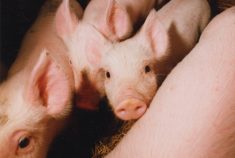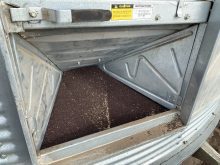Heat-loving crops such as corn and soybeans are delayed, but wheat, canola and flax are thriving this summer under conditions eerily similar to last year’s cooler, but extended growing season.
“It means there has to be some catching up to do in order for the crop to mature and that means we don’t want an early frost,” Brian Jack, a farm production manager with Manitoba Agriculture, Food and Rural Initiatives (MAFRI) said during the annual special crops plot tour July 22. “We need a nice fall.”
Read Also

Gene editing up a better canola crop: FEATURE
Gene editing techniques and maize genetic material may be the seed for more robust and stress tolerant canola plants. Canadian research is trying to make it happen.
Between May 1 and last week the Morden-Carman area had received about 75 per cent of the normal number of crop heat units (CHU) – 50 to 60 fewer than during the same time last year, which was also cooler than normal, Jack said in an interview.
This year crops are even further behind because of delayed seeding or very cold temperatures where seeding wasn’t delayed. Frost in early June set many crops back as well.
As of last week the Morden-Carman area had tallied up 1100 CHU, with 1400 the normal based on 30 years of data, said And Nadler, MAFRI’s agricultural meteorologist. Most corn hybrids require at least 2400 CHU to mature. That’s more than double the number recorded so far.
The length of corn cobs pulled from the Manitoba Corn Committee’s plots the last three years, while not scientific, visually underscores
“It means there has to be some
catching up to do in order for the crop to mature
and that means we don’t want an early frost.”
– BRIAN JACK
the lack of heat this and last growing season. (See photos)
Despite concerns about delayed crop maturity, last year showed a late crop can still be a bumper. The combination of warmer weather last August and an extended frost-free period in the fall saw crops like corn, sunflowers, soybeans and edible beans not only survive, but exceed 10-year-average yields.
Record-high yields were recorded for wheat and canola, which thrive under cooler conditions, underscoring the benefit of growing a wide-variety of crops in a given year.
When trying to forecast the outcome of a growing season there are huge unknowns, such as when the first killing frost will come, Nadler said. Normally, in this area it’s around Sept. 26. That might have been too early for some crops last year.
Not only have temperatures been cooler than normal, with few days reaching 30C, the nights have been much cooler than normal, said Pam de Rocquigny, MAFRI’s cereal specialist.
“Usually southern Manitoba gets a stretch of 30 days and overnight temperatures of 25 or so,” she said.
When it’s that warm heat-loving crops grow all day and night.
Last week overnight temperatures in south-central Manitoba were in the single digits and as low as 6, Nadler said. Other areas, including the southwest and Interlake were even cooler. One night it went down to 3.2 degrees at Moosehorn, Nadler said.
Crops that prefer cooler weather such as wheat, canola, flax and potatoes are thriving, he added. Cooler temperatures have extended canola flowering and the potatoes love it, Nadler said. They do best when temperatures are 23 to 26C. [email protected]
ALLAN DAWSON PHOTOS
INCREDIBLY SHRINKING CORN: Corn height and cob length have declined the last two years due to cooler-than-usual temperatures. In the picture at left Keith Murphy, who manages the Manitoba Corn Committee’s corn plots, holds a cob pulled from a plant July 25, 2007. That year Manitoba farmers harvested a record 117 bushels of corn an acre. The middle picture was taken July 23, 2008 and the one at lower right July 22, 2009. 2007 was warmer than normal. Temperatures at Carman exceeded 30C July 22, 23, 24 and 25, 2007. In fact, July 25, 2007, the temperature in Carman peaked at 34.5C, which in combination with high humidity broke the Canadian humidex record of 53C. During last year’s special crops tour, July 23, most participants donned jackets to keep warm. It was warmer during the tour this year, but slightly fewer crop heat units have been accumulated so far this growing season.



















